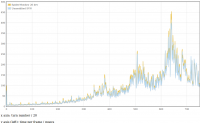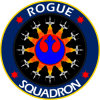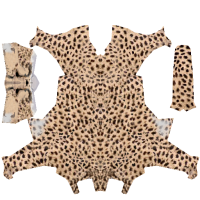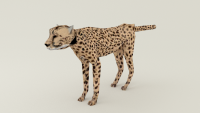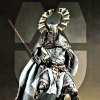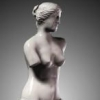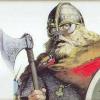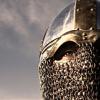Leaderboard
Popular Content
Showing content with the highest reputation on 2014-01-07 in all areas
-
It seems that the current theory has widened the scheme. 1°) It's true that Greek and Etruscan saw each other as "cousin" (the Greek didn't call them "barbaroi"). This was because they were thought as originating from Lydia (and the Anatolian were not barbarian to the Greeks (cf. Troian, etc)). But this theory is now obsolete and only the aristocratic caste is thought to be of oriental ascend. 2°) One of the People of the Sea has landed in now Toscany (the Tyrrhenoi/Tursennoi/Tršw); 3°) They somehow merged with the local Villanova culture, as archaeological evidences show; 4°) In fact, Villanova is the correct name for Bronze Age Etruscans. 5°) Culturally wise, the Etruscan have been influenced by both the Phoenician and Greek cultures, the oriental period coinciding with the arrival of the Tyrrhenoi. http://fr.wikipedia.org/wiki/Terramare http://fr.wikipedia.org/wiki/Culture_de_Villanova 6°) If you go for Etruscans in Aristeia, so should you for early Romans and Dorian Greeks too (no more Mycenians). For those who want a translation (all the sources of this wiki page are Italian books): The Villanovian culture is defined at first by the space where Etruria is already shaped at the beginning of the 1st millenium B.C. (a larger Toscany). This culture, neolithic at first, will eventually correspond to an unique ethnicity that will acquire metallurgy knowledge, iron metallurgy included. Characteristics:Their main archaeological characteristic is the incineration of the death, stored in biconic urns: the similarity with the ritual of the "Urns fields" culture (Danubian plain) lead some historians to link the Villanovian with these peoples. The Villanovians knew iron metallurgy: the ore came from the nearby Elba island. The Greek too knew these deposites and called the island Αἰθαλία / Aithalia. The Villanovians lived in oval, sometimes rectangular, hut villages. They used iron weapons and bronze helmets, cuirasses and quality domestic items. The motives in art were geometrical and the manly face/shape was extremely stylized. Pottery was turned by hand, then by a turn, and was quite original, though influenced by the Greek forms. They appear as sedentary, farmers, herders and warriors (spears, swords, shields, daggers from the rich graves). Women seem to not have been excluded from high social rank or great riches. In spite of a several centuries discontinuity, the Terramare culture may have contributed to the Villanovian culture. Indeed, the remarkable drainage, dikes, canals, and sewerage technologies used by the Villanovian then Etruscan strongly suggest an origin from those Padavian riverside villages. Origins:Villanovians' ancestors may have emigrated from the Black Sea area during the last three centuries of the second millenium B.C. in several waves. As such they are part of the Proto-Celts ("before the Celts"), not unlike other Mediterranean peoples such as Ligurian, Iberian, and Italian. But they were not the first to settle in the area. For instance, we know that Sardinia is inhabited since the 7th millenium B.C. by non Indo-Europeans, a long time before the Shardans (a Sea People) came. Another exemple is the Terramarecoli or People of the Terramare in northern and central Italia. Italian Bronze Age:During Bronze Age, the Italian peninsula was culturally remarkably homogeneous (same pottery, same funerary rituals). However, tumuli are found in southern Italia, likely showing much influence with the Mycenian and Sardinians worlds. The general cypro-mycenian area extended at that time westward to Sardinia and southern Italia. In the north, the Terramare culture may have diffused southward to influence/form the Villanova culture. Early Iron Age:At the beginning of Iron Age, the Villanovian culture expands in all the peninsula. However, evidences are particularly dense on a territory a bit larger that modern Toscany. In this region, the density and remnance of human population are remarkable. Archeological sites are not far away to each other for more than 5 to 15 km. The land shows evidences of a rational and systematic exploitation, as if a vast colonization had been in the process from the 9th century on, and achieved in merely two or three generations. By the end of this process, the landscape is made of many villages of equal size: they house small agrarian communities, and they are the surest hints of a relatively egalitarian society. Beginning of the Etruscan civilization:Then, aristocracy emerged because of a new socio-cultural organization, starting with the new "nuclear family" which replaced the older agrarian community, and with it: the pater familias and the heredium. This is a common evolution in the proto-historic societies, and when you start saying heritage, you can say large heritage and then aristo (plouto)-cracy. This new order would replace the archaic Villanovian society. Roman authors described well this system. From now on, there would be: a king and the people, a base of citizen to recruit infantry, a cast of cavalrymen, elder councils, persons of note and citizen owing them service, nuclear family and larger groups bound by consanguinity and other kinds of relationships. rex / king; populus /people; curiæ / men society, where infantry are recruited from; tribus / tribes, where cavalry are recruited from; patres / elder councils; clientes / citizen owing service to patroni; familiæ / nuclear family; gentes / groups bound by consanguinity and other kinds of relationship. At the same time, in the 9th century B.C., but maybe as early as two or three centuries before (the Sea People are circa 12th century B.C.), small groups of Tyrrhenoi kept coming from the sea in the Villanovian space. These newcomers, small in number (compared to the high density population) merged in the societies they found, without much violence (no evidence of burned villages nor stopping in the on-course colonization Villanovian process). The coming of the Tyrrhenoi marked what the archaeologists call the "oriental period" of the Etruscan civilization. They were indeed not irrelevant to a newborn aristocracy which was at first the only people to use the writing (so far unknown in Etruria). The genetic analysis of remnants in aristocratic graves (7th-2nd centuries B.C.) shows a homogeneous and "Anatolian" origin, that is infirmed by analysis on modern day old Toscanian families, maybe an evidence of a partly exogenous (and not yet mixed) aristocratic caste. Note that the Greek called the Etruscans: Tyrrhenoi and that they traced them either from Lydia (Anatolia) (Herodote) or the island of Lemnos (another island called Aithalia) in the Ægean Sea. Another noticeable foreign influence, at the same time, was the coming of the Phoenician in Western Mediterranean. Those merchants settled in Nora (SW Sardinia) as early as the 9th century and the Etruscan engaged close trading relationship with them. The oriental period: c. 720 B.C. - 580 B.C.The "oriental period" is dated through archaeological material. During this period, the Etruscan were artistically influenced by the Greek (beginning of figurative art). At the same time, the fight against Rome started. The archaic period: c. 600 B.C. - 480 B.C.The Etruscan society became more structured and commercial and cultural exchanges were important. In particular, the painting developed dramatically. Greek pottery were imported. Rome became a republic. In 535 B.C., the Carthagino-Etruscan alliance defeated the Phocean for the control of Western Mediterranean. At the end of the 6th century B.C., the Etruscan expansion was at its greatest, from the Padavian valley north to Campania south. But already, Rome and then the Latin had liberated from the Etrurian subjugation (509 - 506 B.C.), isolating the southern lands from Etruria proper, and soon in the beginning of the 5th century, the Gauls destroyed all the Padavian cities. The classical period: c. 470 B.C. - 350 B.C.In the 5th century B.C., the Etruscan society endured important political and military crisis and the art (archaeological) production decreased. Greek pottery were imported. During this period, the Etruscan allied the Carthaginian against the Greek. Véies was destroyed by Rome which dominated meridional Etruria, and Rome was sacked by the Gaul. The hellenistic period: c. 340 B.C. - 100 B.C.The romanization began progressively. In 295 B.C., they knew their last great defeat in the Social War and in 264 B.C., their religious center, Velzna, was captured. In the 1st century B.C., the acculturated Etruscan had lost political power but their cultural traits had been assimilated by the Roman. They helped the Roman against Hannibal.2 points
-
I guess we are now finally at the point where we can really draw a conclusion about SpiderMonkey performance. After seeing the big improvements from moving the AI to one global in the previous profile, I hoped again that SpiderMonkey would raise from the ashes like a Phoenix(or maybe like a burning fox?) and impress us with some nice performance improvements. The bad news is, it doesn't. The good news is, all of the big performance drawbacks we saw in the previous profiles are gone too and there are only a few smaller peaks left that shouldn't stop us from doing the upgrade. The fact that both graphs are so close together also seems to prove that hidden performance problems affecting the measurement are quite unlikely. I'm disappointed that this is the result of highly talented experts working for about two and a half year on Javascript performance improvements but it also tells me that this way of improving peformance is a lost cause. Here are the graphs: The hash in the end isn't the same but since both graphs are so similar, it's extremely unlikely that the simulation state ends up significantly different. The setup is the same as in the last graph. Now the next steps are: Figuring out if there are significant problems that keep us from using the packaged ESR24 version and then decide which version should be used for the upgrade Fix the remaining problems and bring the patch to a committable state2 points
-
Port forwarding and UPnP have been added to the bot's welcome message.2 points
-
T H R A C I A N S Version Compatibility: SVN (Do not use with standard Alpha) Download repository: https://github.com/0ADMods/thracians Faction Design Document Original post:1 point
-
Ok, I will edit the introduction later. - Romans : Imperial, Western Romans, Eastern Romans - Germans: Alemanni, Franks, Saxons, Goths, Dacians -Middle East factions: Parthian, Sassanids Hindu: Gupta Empire steppes tribes: Huns, Roxolani/Alans 1th Century AD 2nd Century AD 3th Century AD 4th Century AD1 point
-
I highly recommend importing some helmet meshes from the game and checking them out, especially ones that are similar in shape to the one you are attempting.1 point
-
1 point
-
I've got pentagram and wacom Work with mudbox and AO with "ground meshes-terrain" for CryEngine but geting confused when is not a plane to bake from... I even made an tutorial on how to use mudbox + wordmachine for CryEngine terrain but is not in English As I sed I do it just for fun... in about 30minutes... Don't really care if anybody do it or not... Dude_head is from 0AD resources page (dae). Links for tutorials will be really help for me...1 point
-
He, I only see this message now, meanwhile I answered your message, and fixed the problem. Thanks for reporting. (that's what happens when you rename loads of stuff).1 point
-
1 point
-
Sanderd17, you accidentally misspelled phalanx for the Seleucids, the Spartans, and the Thebans on their civ profiles in revision 14534. I sent you a message via the forum message system, but I don't think you know about that system.1 point
-
Hello: I have been working on the Cheetah texture, using 2D graphics program and the Blender´s texture paint tool. This tool don´t have pecision and sometimes make some serious mistakes on areas already completed. It may be the unwrap, but I do not ... After two months without significant progress, I uploading the cheetah´s files. Perhaps someone can be to continue and finish. I don´t know make details on few triangles. I think maybe my working way is wrong. I think I don´t know how finished Hola: He estado trabajando en la textura del gepardo tanto con un programa gráfico 2D como con la con la herramienta de pintura de textura de Blender. Esta última, por lo que he comprobado, no permite mucha pecisión y a veces dá unos errores graves que estropea zonas ya terminadas. Puede que sea debido al unwrap, pero no lo se... Después de dos meses de demora, sin avances significativos, y sin perspectiva de cambio subo, los archivos con los que he trabajado y en la situación en que han quedado por si alguien quiere y puede continuar y acabarlo. No se como lograr detalle en tan pocos polígonos y puede que mi forma de trabajar no sea adecuada. No me veo capaz de continuarlo...1 point
-
1 point
-
1 point
-
1 point
-
1 point
-
Please remember, Lion, that 1,000 A.D. is split up into 2 part. Part one goes roughly from 500 AD till 1000 AD. Part two takes care of the other 500 years.1 point
-
Yeah, ill first have to do a thorough recap on them, just in case I miss something.1 point
-
Thanks, but I like to interpret the archaelogical findings and art from the timeperiod rather than copy off another modern day artist.1 point
-
1 point
-
1 point
-
1 point
-
Ill vote having the Babylonians in They one of the greatest ancient civs... Anyone that doesn't want them shouldn't really be involved.1 point
-
1 point
-
Romulous, I'm afraid I'm not following your criticism. I know how to read and I know what a spy is. Where would you get the idea that I don't?! My argument is that having these special spy units would increase micromanagement without adding anything positive to the gaming experience IMO. So I'm against spy units. However I would like to add something that reveals where the enemy king/emperor/etc. is. A bit like in the (board) game 'Scotland Yard', where the position of Mr. X is revealed periodically. This would allow you to focus your attack force on certain areas of the enemy territory. Sending spies on a mission to discover the location of the leader sounds very reasonable to me. However I don't want to have to move this spy all around the map, diverting my attention from resource management and troop recruitment. Making spies a hidden feature to the game (a bit like Europa Universalis and Crusader Kings, two games I love) would add the novelty of spies adding barely any micromanagement (i.e. you send spies on a mission to discover the location of the enemy king/emperor/etc. and after a while this location will be highlighted so that you know where to send your army. After this mission is complete you can send your spies on a new mission) There would be no spy units that you have to train, move, etc.1 point
-
1 point
-
It is certainly not my choice only. (I'm not the team leader, I'm just taking care of business till NoMolester is online back again.) I was just wondering what would be better.1 point
-
If alpha 16 manages to speed up the game lag considerably, especially with pathfinder (that obviously uses square roots), 'Pythagoras', or 'Pythagorean' could be a very fitting name1 point

.thumb.png.ce58cea22940c255f5b0a735d5abee36.png)


